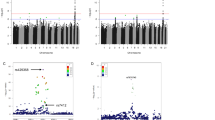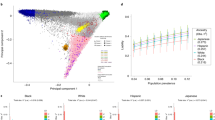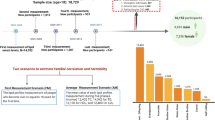Abstract
In an effort to dissect the genetic components of longevity, we have undertaken case–control studies of populations of centenarians (n=338) and adults aged 20–70 years at several polymorphic candidate gene loci. Here we report results on two genes, chosen for their impact on cardiovascular risk, encoding apolipoprotein E (ApoE), angiotensin–converting enzyme (ACE). We find that the ε4 allele of APOE, which promotes premature atherosclerosis, is significantly less frequent in centenarians than in controls (p<0.001), while the frequency of the ε2 allele, associated previously with type III and IV hyperlipidemia, is significantly increased (p<0.01). A variant of ACE which predisposes to coronary heart disease is surprisingly more frequent in centenarians, with a significant increase of the homozygous genotype (p<0.01). These associations provide examples of genetic influences on differential survival and may point to pleiotropic age–dependent effects on longevity.
This is a preview of subscription content, access via your institution
Access options
Subscribe to this journal
Receive 12 print issues and online access
$209.00 per year
only $17.42 per issue
Buy this article
- Purchase on Springer Link
- Instant access to full article PDF
Prices may be subject to local taxes which are calculated during checkout
Similar content being viewed by others
References
Abbott, M.H., Murphy, E.A., Bolling, D.R. & Abbey, H. The familial component in longevity, a study of the offspring of nonagenarians II. Preliminary analysis of the completed study. Johns Hopkins med. J. 134, 1–16 (1974).
Finch, C.E. Genetic influences on lifespan, mortality rates, and age-related diseases. In Longevity, senescence and the genome, p. 298–352 (University of Chicago Press, Chicago, 1990).
Schächter, F. & Cohen, D. Longevity: a new field for human genetics. Lifespan 4, 1–3 (1993).
Schächter, F., Cohen, D. & Kirkwood, T.B.L. Prospects for the genetics of human longevity.Human Genetics 91, 519–526 (1993).
Proust, J. et al. HLA and longevity. Tissue Antigens 19, 168–173 (1982).
Takata, H., Ishii, T., Suzuki, M., Sekiguchi, S. & Iri, H. Influence of major histocompatibllity complex region genes on human longevity among Okinawan-Japanese centenarians and nonagenarians. Lancet ii, 824–826 (1987).
Hatton, F. & Michel, E. Les causes de mortalité en 1990. Insee première 196, mai 1992.
Zannis, I. et al. Proposed nomenclature of apoE isoproteins, apoE genotypes and phenotypes. J. lipid Res. 23, 911–914 (1982).
Davignon, J., Gregg, R.E. & Sing, C.F. Apolipoprotein E polymorphism and atherosclerosis. Arteriosclerosis 8, 1–21 (1988).
Van Bockxmeer, F.M. & Mamotte, C.D.S. Apolipoprotein ε4 homozygosity in young men with coronary heart disease. Lancet 340, 879–880 (1992).
Eto, M., Watanabe, K. & Makino, I. Increased frequencies of apolipoprotein ε2 and ε4 alleles In patients with ischemic heart disease. Clin. Genet. 36, 183–188 (1989).
Tiret, L. et al. Evidence, from combined segregation and linkage anylysis, that a variant of the angiotensin I-converting enzyme (ACE) gene controls plasma ACE levels. Am. J. hum. Genet. 51, 197–205 (1992).
Cambien, F. et al. Deletion polymorphism in the gene coding for angiotensin-oonverting enzyme is a potent risk factor for myocardial infarction. Nature 359, 641–644 (1992).
Tiret, L. et al. Deletion polymorphism in angiotensin-converting enzyme gene associated with parental history of myocardial infarction. Lancet 341, 991–992 (1993).
Hixson, J.E. & Vernier, D.T. Restriction isotyping of human apolipoprotein E by gene amplification and cleavage with HhaI. J. lipid Res. 31, 545–548 (1990).
Rigat, B., Hubert, C., Corvol, P. & Soubrier, F. PCR detection of the insertion/deletion polymorphism of the human angiotensin converting enzyme gene. Nucl. Acids Res. 20, 1433 (1992).
Bailleul, S. et al. Direct phenotyping of human apolipoprotein E in plasma: application to population frequency distribution in Paris (France). Hum. Hered. 43, 159–165 (1993).
Boerwinkle, E., Lee, S.S., Butler, R., Schumaker, V.N. & Chan, L. Rapid typing of apolipoprotein BDNA polymorphisms by DNA amplification. Atherosclerosis 81, 225 (1990).
Peacock, R. et al. Apolipoprotein B gene polymorphisms, lipoproteins and coronary atherosclerosis: A study of young myocardial infarction survivors and healthy population-based individuals. Atherosclerosis 92, 151–164 (1992).
Andrew, S. et al. Nonrandom association between Huntington disease and two loci separated by about 3 Mb on 4p16.3. Genomics 13, 301–311 (1992).
Weber, J.L. & May, P.E. Abundant class of human DNA polymorphisms which can be typed using the polymerase chain reaction. Am. J. hum. Genet. 44, 388–396 (1989).
Fries, J.F. Aging, natural death and the compression of morbidity. New Engl. J. Med. 303, 130 (1980).
Ordovas, J.M., Litwack-Klein, L., Wilson, P.W.F., Schaefer, M.M. & Schaefer, E.J. Apolipoprotein E isoform phenotyping methodology and population frequency with identification of apoE1 and apoE5 isoforms. J. lipid Res. 28, 371–380 (1987).
Utermann, G., Steinmetz, A. & Weber, W. Genetic control of human apolipoprotein E polymorphism: comparison one- and two-dimensionai techniques of isoprotein analysis. Hum. Genet. 60, 344–351 (1982).
Boemi, M. et al. Gender differences in a type 2 (non-insulin-dependent) diabetic population with respect to apolipoprotein E phenotype frequencies. Diabetologia 36, 229–233 (1993).
Jeunemaître, X., Lifton, R.P., Hunt, S.C., Williams, R.R. & Lalouel, J.M. Absence of linkage between the angiotensin converting enzyme locus and human essential hypertension. Nature Genet. 1, 72–75 (1992).
Ehlers, M.R.W. & Riordan, J.F. Angiotensin-converting enzyme: new concepts concerning its biological role. Biochemistry 28, 5311–5313 (1989).
Costerousse, O., Jaspard, E., Wei, L., Corvol, P. & Alhene-Gelas, F. The angiotensin I-converting enzyme (kininase II): molecular organization and regulation of its expression in humans. J. cardiovasc. Pharmacol. 20 (suppl. 9), S10–S15 (1992).
McGeer, E.G. & Singh, E.A. Angiotensin-converting enzyme in cortical tissue in Alzheimer's and some other neurological diseases. Dementia 3, 299–303 (1992).
Eisenlohr, L.C., Bacik, I., Bennink, J.R., Bernstein, K. & Yewdell, J.W. Expression of a membrane protease enhances presentation of endogenous antigens to MHC class I-restricted T lymphocytes. Cell 71, 963–972 (1992).
Jorgensen, J.O.L. & Christiansen, J.S. Brave new senescence: GH therapy in adults. Lancet 341, 1247 (1993).
Donald, J.A. et al. Linkage relationships of the gene for apolipoprotein CII with loci on chromosome 19. Hum. Genet. 69, 39–43 (1985).
Strittmatter, W.J. et al. Apolipoprotein E: high avidity binding to β-amyloid and increased frequency of type 4 allele in late-onset familial Alzheimer disease. Proc. natn Acad. Sci. U.S.A. 90, 1977–1981 (1993).
Corder, E.H. et al. Gene dose of apolipoprotein E type 4 allele and the risk of Alzheimer's disease in late onset families. Science 261, 921–923 (1993).
Skoog, I., Nilsson, L., Palmertz, B., Andreasson, L.A., Svanborg, A. A population-based study of dementia in 85-year-olds. New Engl. J. Med. 328, 153–158 (1993).
Kirkwood, T.B.L. & Rose, M.R. Evolution of senescence: late survival sacrificed for reproduction. Phil. Trans. R. Soc. Lond. B 332: 15–24 (1991).
Author information
Authors and Affiliations
Rights and permissions
About this article
Cite this article
Schächter, F., Faure-Delanef, L., Guénot, F. et al. Genetic associations with human longevity at the APOE and ACE loci. Nat Genet 6, 29–32 (1994). https://doi.org/10.1038/ng0194-29
Received:
Accepted:
Issue Date:
DOI: https://doi.org/10.1038/ng0194-29
This article is cited by
-
Polygenic scores for estimated glomerular filtration rate in a population of general adults and elderly – comparative results from the KORA and AugUR study
BMC Genomic Data (2023)
-
The CEPH aging cohort and biobank: a valuable collection of biological samples from exceptionally long-lived French individuals and their offspring for longevity studies
GeroScience (2023)
-
Proteomic basis of mortality resilience mediated by FOXO3 longevity genotype
GeroScience (2023)
-
A high-throughput real-time PCR tissue-of-origin test to distinguish blood from lymphoblastoid cell line DNA for (epi)genomic studies
Scientific Reports (2022)
-
Metagenomic and metabolomic remodeling in nonagenarians and centenarians and its association with genetic and socioeconomic factors
Nature Aging (2022)



